Whether you think of Absinthe as a creativity spawning elixir, or just a super delicious drink, there’s no denying that the green fairy is cloaked in a bit of mystery. Let’s zero in! 10 facts and myths. Learn all about absinthe, and how a once celebrated spirit went from banned substance to reborn. Exquisite flavor – and makes a great gift!

“Wait… the what?” I asked.
“The green fairy,” said the Australian with the nose that sat sideways on his face from one too many rugby scrums. “You know, absinthe.”
I actually didn’t know. And I was wondering how many beers he had managed to consume before I met up with him. He had downed, like, three since I arrived at the small terrace bar in Plaça de George Orwell in Barcelona’s Barri Gòtic (Gothic Quarter) 30 minutes prior.
“It’s a drink,” he said.
You see, in the late 90s, absinthe wasn’t legal in the US or much of Europe, but it was A-OK in Spain; a fact Justin the Aussie barbarian knew well.
And while he was right about those facts (1. It is a drink – a spirit actually – and 2. at the time, it wasn’t widely legal), he then went a bit off the rails. (In all fairness, I didn’t know he was wrong about some of this stuff until later.)
“Yeah – you burn a sugarcube and drop it into this green drink – and you might hallucinate green fairies,” he said in all earnestness.
Um. This I had to see firsthand.
We made our way to a dark bar with illuminated bottles full of greenish spirits on display. Aussie Justin did the ordering.
After he dipped a large sugarcube in the wormwood infused absinthe – then placed the drenched cube on the slotted absinthe spoon atop the glass and set it on fire, I could see the bartender shaking his head.
A patron at the table sitting next to us said, “You’re doing that wrong.”
But maybe I should back up to the beginning. Heck, I haven’t even introduced myself yet.

Hello! My own introduction to Absinthe
Hey guys! I’m Ben. Caroline’s husband.
And, while you don’t hear from me much, I work behind the scenes at Pickled Plum. Quite greedily, I’ve managed to sample a taste of almost all the recipes Caroline makes for Pickled Plum before they’re published. Lucky me!
Back in the day (like, when people still used Travelers Cheques) my parents struck a deal with me: finish college and they’d pick up the tab on airfare to and from Europe.
You see, I was a lousy student, headed for mountains of mediocrity. And I think this was their last-ditch (and generous!) effort to help me suck it up before they just tossed in the towel and let me sink on my own.
Whether you prefer to call it a carrot-on-a-stick or a full-on bribe, it worked.
I soon curtailed my habit of blowing off class and only doing some of the assignments – and became an exemplary student.
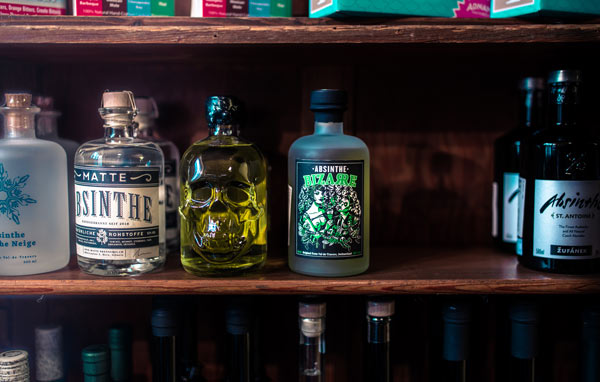
I took 21 credits each semester of my senior year. While it was stressful, I found that I actually enjoyed not sucking at life.
And, true to their word – degree in hand, that magical plane ticket was mine thanks to a deft motivational chess move by my awesome parents!
After a few months of acting like a vagabond throughout the UK and Western Europe, I found myself in Barcelona, talking with an insane Australian rugby player with a crushed nose about possibly meeting ‘the green fairy.’
And, once a kind Spaniard taught us the right way to prepare and drink absinthe, it became one of my favorite libations.
In the months to come, the Aussie and I found ourselves regularly looking forward to the green hour – and the hijinx that tended to follow.
Let’s take a closer look at absinthe!

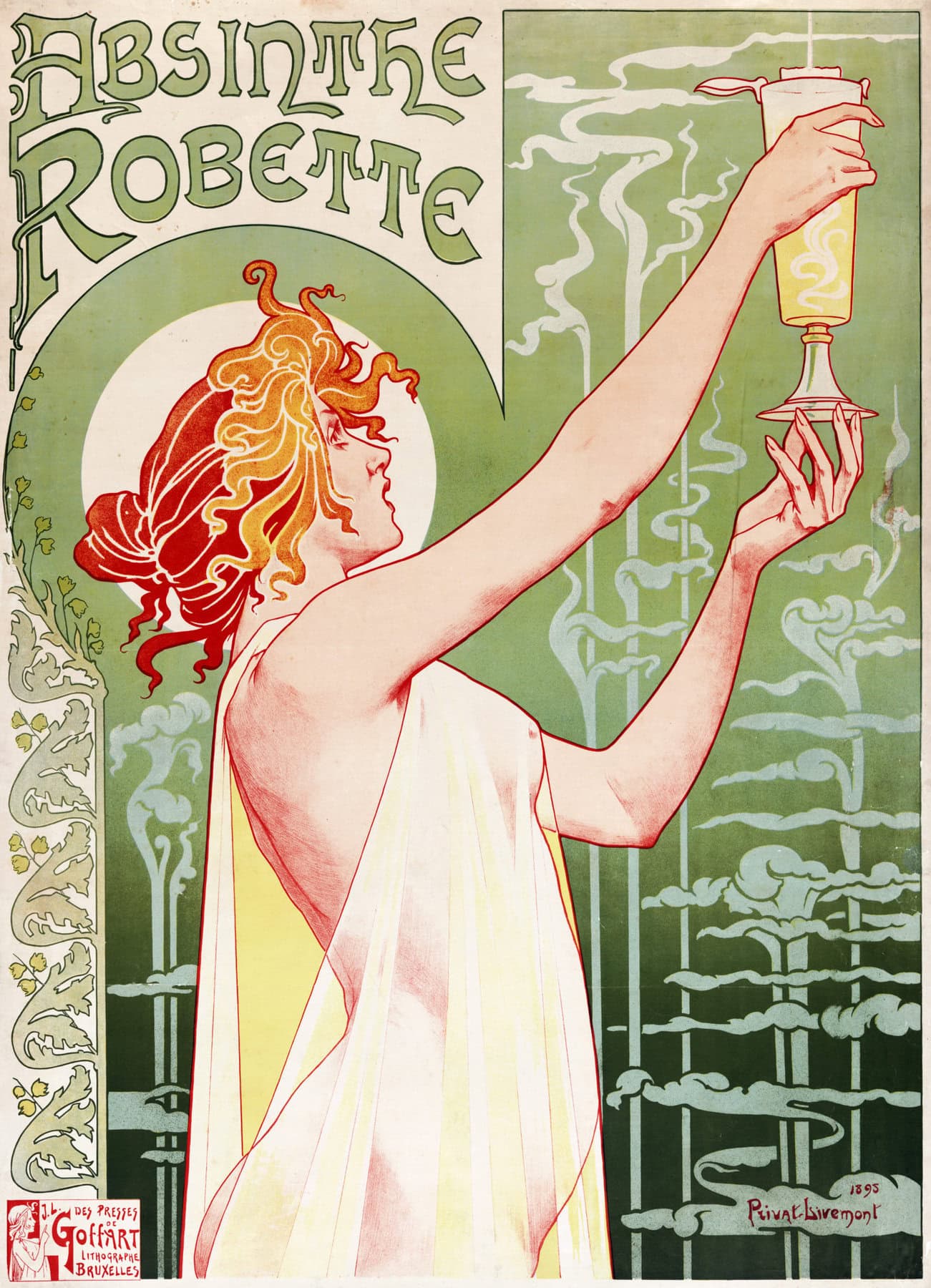
1. What is absinthe?
If you were to venture a guess like: absinthe is that potent green drink that tastes kind of like black licorice and used to be banned, you’d generally be on the right path.
But let’s zero in.
At its most basic, absinthe is an anise flavored spirit, traditionally made from – and flavored by – botanicals. The most famous of these is the herbaceous perennial called wormwood (or grand wormwood).
With a relatively high ABV (alcohol by volume), it is common to dilute absinthe with water prior to drinking.

While this is partially to mitigate the high proof, it is also frequently done to cut, enhance and open up the flavor.
Throughout its history, absinthe has experienced the height of cultural acceptance, as well as tumultuous lows (including an outright ban throughout much of the world in the 20th century).
You see, during La Belle Époque, absinthe was incredibly popular among European artists, writers and socialites. Chances are, if it was painted or written in the late 1800s to early 1900s, absinthe may have played a small, background role in the… ahem, inspiration phase.
Even later in 1940s Spain, Hemingway wrote about absinthe in his novel For Whom the Bell Tolls as, “…that opaque, bitter, tongue-numbing, brain-warming, stomach-warming, idea changing liquid alchemy.”
In the early 1900s Absinthe was banned in Belgium, Holland, Switzerland, The US and France.
Much of the production at that time either folded entirely, went underground – or moved operations to Spain.
Btw… While I love absinthe – and am excited to be sharing my limited knowledge with you – this information may seem a bit pedestrian for connoisseurs and deep-divers on the subject.
Think of the preceding and following as a beginner’s guide to absinthe 🙂


2. What does absinthe taste like?
Ever tried pastis, ouzo, arak or sambuca? Then you’re probably familiar with the black licorice-like flavor these spirits possess.
Absinthe, from a taste perspective, is like a distant (and very cool) cousin.
Yes, there is an anise flavor – however, there is a ton more going on. Many of those licorice notes we know and love in real absinthe come from use of fennel and green anise utilized during the distillation process.

Add grand wormwood to the mix and we’re getting there!
In fact, to many absinthe aficionados, green anise, florence fennel and grand wormwood are called ‘the holy trinity.’
However, you’re also likely to find notes of things like peppermint, coriander, hyssop, lemon balm, angelica and veronica in the mix – lending their botanical complexities to the overall flavor.
A good bottle of absinthe is a bit of a mystery from a flavor perspective, hiding a hint of this behind a wall of that.
The flavors tend to unfurl and develop, revealing different properties depending where you are in the swallow.
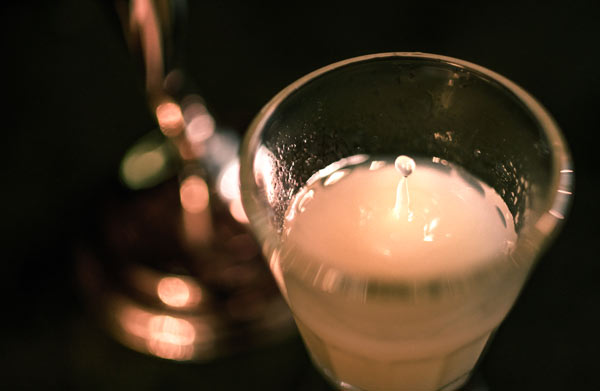
And, much like you’ll find different taste values in things like whiskey, beer and wine – you’ll get a vast range of flavors from one brand of absinthe to another.
But if you were to hold me down and absolutely demand a description of the flavor in general, I’d probably say something like:
a refreshing (almost Alpine), floral, spicy, fruity and slightly bitter herbal concoction that happens to have an essence of black licorice in the mix.
Scientifically accurate? Nope. Flowing prose? Hardly! But it sums up what I taste most times when I partake in a sip or seventeen.

3. How to drink Absinthe
OK. Let’s get down to brass tacks. If you’re like me, this is the best part!
There are a few ways to go about preparing and drinking absinthe, and I’ll do my best to keep it simple.
- The old school, proper way: Pour between an ounce to an ounce-and-a-half or so of absinthe into a glass. This is what an absinthe glass looks like (yep – it’s an actual thing). Then rest a slotted spoon over the top of the glass. Place a sugar cube on top of the spoon. Then, very slowly, pour ice-cold water over the top of the sugar cube. The sugar will break apart and fall into your absinthe, along with the water. The water will turn your green absinthe cloudy – almost milky. That’s called the louche. Depending on your taste, you’re looking for a water to absinthe ratio of between 3:1 to 5:1. (Some absinthe glasses actually have fill lines for your absinthe and water. Go with your taste though.) Stir, and you’re good to go! Now, you don’t need an absinthe fountain to dispense the water. But, hey – do you!
- A bit more modern: Use any old glass – and add your absinthe and water (slowly!) like the method above. However instead of the whole rigamarole with the sugar cube, just add a splash of simple syrup for the sweet element.
- Make a cocktail: Hey, it may be a starter method, but there’s no shame in having a gateway drink just to try the flavor of absinthe on for size. I’m no mixologist, so I’ll leave it to you to Google yourself up some postmodern absinthe cocktail perfection!
Now – back to the whole sugar thing. What’s that all about?

4. Why do you add sugar to absinthe? Should you add sugar to absinthe?

Well, that’s a nuanced thing indeed.
Absinthe can be a tad strong. Seriously! The absinthe alcohol percentage can vary greatly – between approximately 53% to 75% ABV. That’s up to around 148 proof on the high end!
And some absinthe recipes tend to present a few bitter elements from the botanicals.
One way to address that is the addition of cold water, which dilutes the strong absinthe and unlocks some of the depth and flavor characteristics (much in the same way a few drops of water can really open up a good whiskey).
Another is to add a bit of sweetness via sugar.
Sugar’s sweetness can temper the bitterness – and add yet another flavor to the already crowded palate.

While the water is not really optional, from a personal standpoint, I’ve never been a big fan of adding a ton of sugar to my absinthe.
A little is fine. But I personally prefer to let the absinthe speak for itself.
Generally, French absinthe tends to be a bit stronger (~68-75% ABV). And Swiss absinthe tends to sit around the 53-55% mark.
Some say Swiss absinthe requires little to no sugar.
But, I’d counter that your own personal tastes will determine whether you add just water or both water and sugar to your absinthe.
Play around and find your own personal sweet spot!

5. Should I burn the sugar cube?
Simply put: NO.
Step away from the matchbook!
That bit of theater likely started in the 1990s in some untz-untz nightclubs as a way to make absinthe seem cool. Hint: it was already cool 🙂
The burning practice may very well have pulled double duty – covering up the fact that some sub-par absinthe won’t louche (turn milky and cloudy) when water is added.
In fact, a good way to visually test absinthe is to have a look at the color once you’ve added some water. While there are brands of absinthe that are clear, much absinthe is greenish – and will turn cloudy upon slowly adding water. If you have an absinthe that stays Midori-green after adding water, that’s probably more artificial colors at play than actual botanicals.
Anyhow, I digress… While dipping your sugarcube in highly flammable spirits and setting it ablaze looks cool, it ends up ruining the flavor of a subtly and aggressively flavored absinthe.

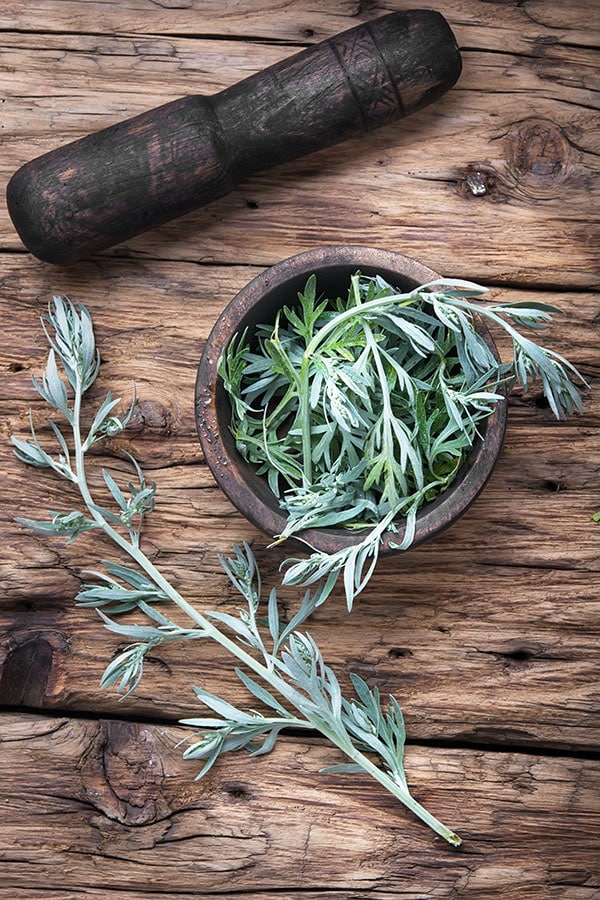
6. What is wormwood?
Without going over the top third-period-science-class about this, wormwood (actually grand wormwood) is the name most of us use instead of trying to sound out artemisia absinthium.
It’s an herbaceous perennial plant with greenish leaves – and its oils just happen to be a big contributor to the botanical mix that makes up absinthe.
Now, wormwood also contains a chemical compound called thujone – which was rumored to be a hallucinogen and cause, um… transformations in the mind.
True, there is a level of toxicity inherent to thujone at extremely high doses. But not in any form we’re ever going to encounter.
The reality is that thujone has a pretty low presence in absinthe. And furthermore, thujone is found in similarly small quantities in all sorts of everyday stuff like common sage and oregano.

7. Is absinthe hallucinogenic?
So, as much as it was rumored to be a mind-bending hallucinogen in the 19th century, real absinthe is not going to make you trip out. Period.
That’s one of the longest standing myths about absinthe.
Turns out that part of the lore that made absinthe attractive to many of the free thinkers and artists of La Belle Époque, ended up working to absinthe’s detriment and ultimate demise in the early 1900s.
As I touched on before, poor public opinion (based on some fairly shoddy science) resulted in absinthe being banned in many of the places it was most enjoyed.
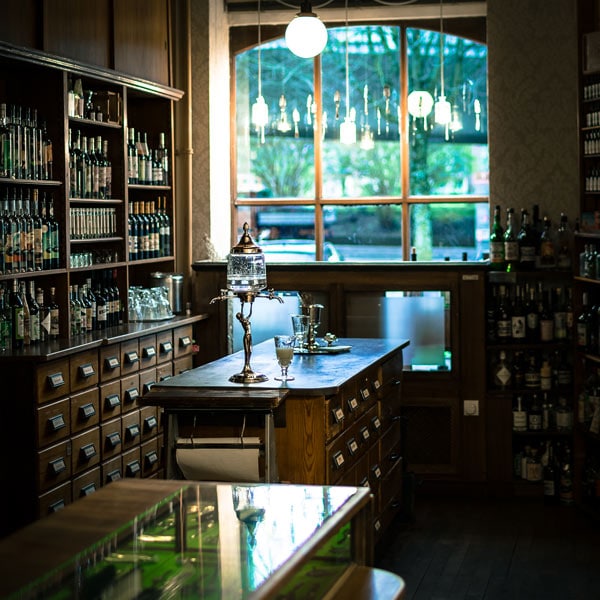
In fact a popular French doctor of the day even went so far to say that absinthe was the root of society’s ills. Heck, he even blamed absinthe for what he saw as the collapse of French culture. Whoa.
Now, it may be that a few unscrupulous absinthe makers all those years ago added illicit compounds to their own batches to cause their client base to experience something else.
But there’s nothing about the presence of wormwood or thujone in absinthe that is going to cause hallucinations. Unfortunately, alcohol poisoning would get to you long before you could ingest enough thujone to do any damage. (Btw… don’t do that!!)
Absinthe effects are basically the same effects you get from other booze with a high proof.
It’s a strong drink.
And it’s probable that, just like with any other alcohol, overindulgence and the ‘craziness’ that typically follows said overindulgence, fueled the idea that absinthe was hallucinogenic.
I mean, I’m definitely not a doctor, but I know people that act LEGIT CRAZY after a few too many shots of tequila.

8. So, Is absinthe legal?
Short answer: it’s super likely!!
Depends on where you live. If you can buy alcohol, you can buy absinthe.
Throughout Europe, the Americas, Australia and parts of Asia, it’s legal to stock and buy absinthe.
If you’re of legal drinking age – and live in a country where alcohol isn’t outright illegal, then you’re good to go.
That means absinthe is legal in the US?
Yep – after the ban lifted in 2007, you can totally buy absinthe in the US. But with one slight caveat (that almost isn’t even a thing).
You see, while you can walk into a liquor store in the US and see absinthe for sale, that absinthe has to have a thujone level no higher than 10 milligrams per liter.
While the EU has a thujone limit of 35 mg per liter, most commercially produced absinthe sits at right about the 6 mg per liter level – which kinda renders that lower US limit a non-issue.
Yay!

9. What is the best absinthe?
Maybe you’ve read this and are thinking you’d like to try a sip or two of the green fairy.
Nice. I like your style!
The flavors of absinthe can differ greatly. As such, finding your first bottle can seem like a bit of an overwhelming hurdle.
Where can I buy absinthe?
Thankfully, for this herculean seeming task, there’s Absinthes.com – a site that everyone from a true beginner, all the way to a pro with the collective absinthe-knowledge of Toulouse-Lautrec, can find what they’re looking for.
Or, hey – maybe you read this and are like, “nah – not for me,” – BUT you have someone in your life that would totally be into this.
Well, absinthe makes a great gift!
The best absinthe is going to be the one with flavors that speak to you personally. I can’t think of a better absinthe resource to walk you through the steps of finding it!

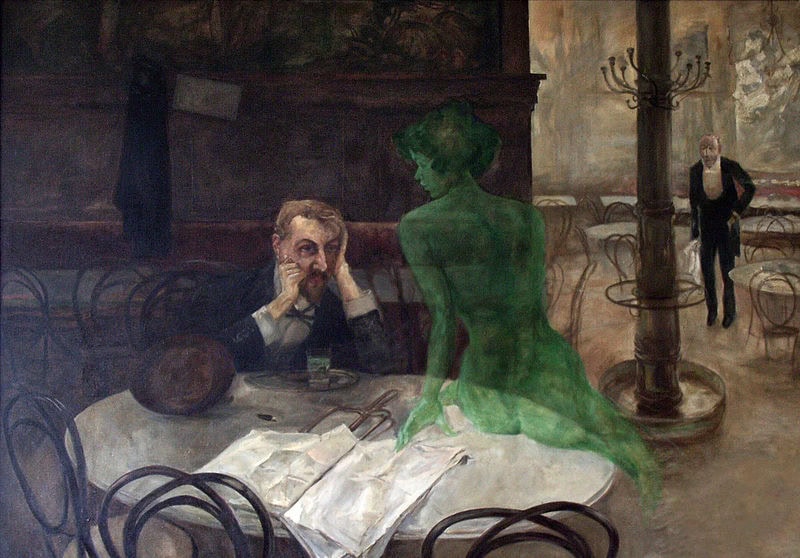
10. So, what is the green fairy??
Oh yeah – that.
The green fairy is the English translation of the French: la fée verte.
And while some might just chalk that up up to an affectionate nickname creative types donned on absinthe – others might get a tad more mystical about the whole thing.
To the OG artists, writers and free thinkers in late 1800s Paris, the green fairy may have been a metaphor for enlightenment and transformation.
It became so ingrained in the argot of the day, that the phrase l’heure verte – or the green hour – was born. Interestingly enough, many historians consider that phrase to be the birth of concept for the modern day Happy Hour.
I’d guess that the green fairy, at the very least, spawned some fun, hedonistic and debaucherous nights that were fuel for later inspiration on the canvas and on the page.
And, thanks to the previous ban on absinthe being lifted in 2007, maybe the green fairy can spark a little flourish of creativity in the modern age as well!
Not in the mood for absinthe tonight? How about a simple, delicious cocktail:
- Kentucky Buck
- Rooftop Lemonade
- Rosemary Ginger Whiskey Sour
- Sour Appletini
- Frosé Cava Cocktail
- Gazpacho Bloody Mary
- Fresh Ginger Moscow Mule
Plus:
Did you like this Absinthe For Beginners Tutorial? Have you tried absinthe? Share your tips and recommendations in the comments section below!















I’ve never tried Absinthe because of the ban and the warnings that it could kill you the reason being it was banned. Always been curious because of other stories that it did make you feel really good. Diane Hicks
Great article! Well written and very informative.
However, none of the links work! I’m looking to buy some Absinthe. I guess I’ll have to ask the Google!
Thank you for letting me know Richard! Let me take a look at the links to make sure they are back up!
Well summed up and written. Thank you.
This was quite enlightening. Thank you very much. I’m going to give spirit a try.